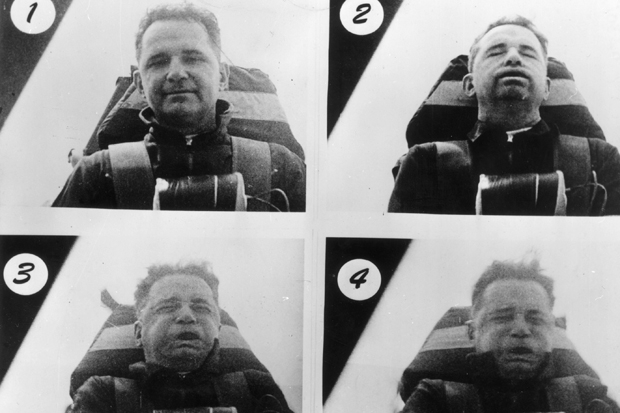There’s a moment in Craig Ryan’s spectacular biography of John Paul Stapp — the maverick American Air Force doctor who, in the 1950s, became the fastest man on earth — where the reader falls inexorably in love with Ryan’s subject. It’s on page 17, when Stapp encounters what his Baptist missionary father had taught his sons to prepare for: ‘The epiphany that would illuminate the nature of their calling.’
Christmas is three days gone, and Stapp’s two-year-old cousin, momentarily alone in front of the fireplace, throws part of the Sunday newspaper over the grate. It ignites, catching the boy’s cotton pyjamas, setting them ablaze. Someone plunges the child into a tub of icy water outside, but the burns are horrific. The 18-year-old John Paul (named after his father’s favourite two apostles) watches as the local doctor treats the boy with a mixture of lime and linseed oil, and John Paul remains awake for the better part of 60 hours at his cousin’s side, doing what he can, until, inevitably, the boy dies. The adolescent Stapp rages against the ineffective ‘dolt’ of a doctor, who, in Stapp’s opinion, should have immediately transported the boy to hospital in nearby Austin. Rendered with the unsentimental clarity of Ryan’s prose, the event is heartbreaking.
The incident galvanises the young Stapp into his cause: the protection of the human body By the time of his own death, in 1999, he was perhaps ‘indirectly responsible for saving more lives than anyone in history’.
In 1944, during his second year of medical school, Stapp was drafted into the United States Medical Corps. Enamoured by aviation, he applied to the School of Aviation Medicine and became a flight surgeon. He accepted a project at Muroc Air Base, a remote and desolate place up in the high elevations of the bone-dry Mojave desert, which was about to become the touchline of the future. Stapp had recently encountered pilot ejection systems and was convinced that men, properly restrained and protected in their planes, could walk away from violent crashes. For this, his ‘band of pirates’ would employ a piece of Muroc equipment that would make him famous: the rocket sled test vehicle — a seat that would accelerate along a 2,000-foot track at incredible speed and stop on a dime, thus simulating the effects of ejection from a speeding aircraft.
Across the base were the men he sought to save: test pilots like Chuck Yeager, who was preparing to fly faster than the speed of sound in the Bell X-1 research rocket plane. Stapp’s decision to ride the rocket sled himself as a human volunteer was one that caused him to have a tempestuous relationship with his air force superiors for the duration of his military life. On the next generation rocket sled, ‘Sonic Wind’, Stapp pushed himself to the brink of human endurance at speeds of over 600 mph and forces in excess of 46 gs (literally faster than a speeding bullet).
It was the beginning of an extraordinary career in which Stapp pioneered man’s capacity for space flight. His work on the high-altitude balloon research of Project Manhigh was the first space programme, predating the formation of Nasa by three years. Stapp’s work provided a bedrock for the start of the space race and his influence and consultation stretched from the first astronaut selection of Project Mercury through Apollo and on into the Shuttle era, also introducing the concept of what would become the International Space Station.
John Paul Stapp was the grandfather of manned space flight. Stapp’s greatest legacy, however, was a 15-year-long battle with car manufacturers and politicians to get the seatbelt into America cars, which were claiming 50,000 American lives every year (and three million injuries). By applying his air force research to the auto industry, this number was drastically reduced and countless lives — including those of his brother’s children — were saved.
Sonic Wind (terrible title aside) is a tremendous feat of storytelling that transcends its biographic genre, with the character of Stapp propelling the narrative — he was a playful, offbeat, complex man; moral, kind, charming, highly resourceful, self-sufficient and unorthodox; a hustler, a rebel with a cause. Dressed, as he always was, in full regulation uniform, including necktie, dress shoes and hat, he possessed a priest-like fervour, born out of his parents’ missionary work in Brazil, and a soothing Texan cadence.
This book is, at heart, a family drama writ large; heartbreaking, life-affirming, full of unrequited love, selfless love, illicit love, adopted love, family secrets, near-death experiences and peppered with glorious detail. Ryan achieves an emotional resonance rare in historical biography: this is a story for the masses and the movies, and deserves to be a ‘breakaway phenomenon’.






Comments